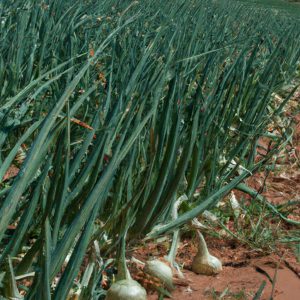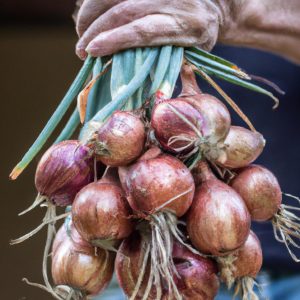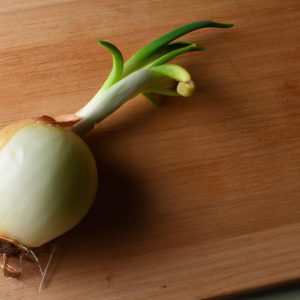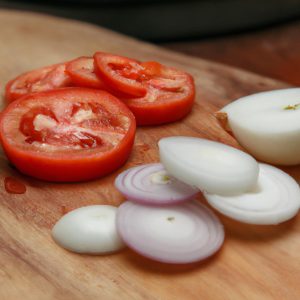Do you want to save money on groceries and reduce food waste? Growing green onions from scraps is an easy and sustainable solution. Not only will you have a fresh supply of green onions whenever you need them, but you’ll also be doing your part to reduce your carbon footprint.
Green onions, also known as scallions, have been a popular ingredient in various cuisines for centuries. They have a long history of being used in traditional Chinese medicine for their health benefits. Today, green onions are used in various dishes worldwide, from salads to soups to stir-fries.
Sustainable gardening practices are becoming increasingly popular, and growing green onions from scraps is one of the easiest ways to start. You can grow them indoors or outdoors, and all you need is a container, soil, and green onion scraps. This method not only reduces food waste but also helps you save money on groceries.
In the following sections, we’ll guide you through the process of growing green onions from scraps. We’ll cover everything from selecting the right scraps to caring for your growing green onions. So let’s get started!
Selecting the Right Scraps

Are you ready to start growing your own green onions from scraps? The first step is to select the right scraps. Not all scraps are suitable for planting, so it’s important to know which ones to choose.
Types of Green Onion Scraps that are Suitable for Planting
The white ends of green onions are the part that’s usually used in cooking, but did you know that the green tops can be used for regrowth? Both the white and green parts can be used to grow green onions, so don’t throw them away!
How to Identify Healthy Scraps
When selecting scraps for planting, it’s important to choose healthy ones. Look for scraps that are firm and not wilted or slimy. If the scraps have roots, that’s even better!
Preparing the Scraps for Planting
Before planting the scraps, it’s important to prepare them properly. Cut off the roots and the top 2-3 inches of the green part. You can use the remaining scraps for cooking if you’d like. Place the scraps in a container of water, making sure that the white ends are submerged. Change the water every few days to keep it fresh. After a few days, you should notice roots starting to grow from the white ends.
Now that you’ve selected and prepared your green onion scraps, you’re ready to move on to the next step: preparing the soil.
Preparing the Soil

Choosing the Right Soil
The first step in preparing the soil for growing green onions is to choose the right soil. Green onions prefer soil that drains well and is rich in nutrients. You can use a general-purpose potting soil, but it’s best to mix in some compost or vermiculite to improve drainage.
Adding Organic Matter to the Soil
Adding organic matter to the soil is essential for providing the necessary nutrients for green onions to grow. You can use compost, aged manure, or a commercial organic fertilizer to add organic matter to the soil. If you’re using compost or aged manure, mix it into the soil before planting the green onion scraps. If you’re using a commercial organic fertilizer, follow the package instructions for the recommended amount and application method.
Fertilizing the Soil
Green onions don’t require a lot of fertilizer, but it’s important to provide them with some nutrients to promote healthy growth. You can use a balanced fertilizer with equal amounts of nitrogen, phosphorus, and potassium. Apply the fertilizer according to the package instructions, being careful not to over-fertilize, as this can lead to burned roots and stunted growth.
Planting Green Onion Scraps

Choosing the Right Container
When it comes to planting green onion scraps, choosing the right container is crucial. You can use any container that is at least 6 inches deep and has drainage holes. You can use plastic or ceramic containers, but make sure they are clean and disinfected before use to prevent any fungal or bacterial growth.
Planting the Scraps in the Container
Once you have your container, it’s time to plant the green onion scraps. Fill the container with potting soil, leaving about an inch of space at the top. Take the green onion scraps and insert them into the soil, making sure the white root end is facing down. Space the scraps about an inch apart and make sure they are firmly planted in the soil.
Watering the Newly Planted Scraps
After planting your green onion scraps, water them thoroughly. Make sure the soil is moist, but not waterlogged. You can use a watering can or spray bottle to water the scraps gently. Place the container in a sunny spot, and make sure to water the scraps regularly to keep the soil moist.
Congratulations! You’ve successfully planted your green onion scraps, and now it’s time to watch them grow. In the next section, we’ll discuss how to care for your growing green onions.
Caring for Green Onion Scraps
Growing green onions from scraps is an easy and low-maintenance process. However, there are a few things you need to keep in mind to ensure that your green onions grow healthy and strong. Here are some tips for caring for your growing green onions:
Providing Proper Sunlight
Green onions thrive in moderate to full sunlight. If you’re growing them indoors, make sure to place them near a sunny window or under grow lights. If you’re growing them outdoors, choose a spot that receives at least six hours of sunlight a day.
Watering the Growing Green Onions
Green onions need to be watered regularly to keep the soil moist. However, be careful not to overwater them, as this can lead to root rot. The frequency of watering will depend on the climate and the type of soil you’re using. As a general rule, water your green onions whenever the top inch of soil feels dry to the touch.
Harvesting the Green Onions
Once your green onions have reached the desired height, it’s time to harvest them. You can either harvest the whole plant or just the green stalks, depending on your needs. To harvest the whole plant, gently pull it out of the soil, roots and all. To harvest just the stalks, use a pair of scissors or a sharp knife to cut them off at the base.
Remember to always leave a few green onions to continue growing if you want to have a continuous supply of fresh green onions. With proper care, you can enjoy a bountiful harvest of green onions from scraps in no time!
Conclusion
Growing green onions from scraps is an easy and sustainable way to reduce food waste and save money on groceries. By following the steps outlined in this guide, you can enjoy a fresh supply of green onions whenever you need them.
Remember to select healthy scraps, prepare the soil properly, and provide adequate care for your growing green onions. Sustainable gardening practices are not only beneficial to you but also to the environment.
At onionfacts.com, we encourage you to try growing your own green onions from scraps. It’s a fun and rewarding experience that will help you become more self-sufficient. Plus, it’s a great way to reduce your carbon footprint and contribute to a more sustainable future.
So what are you waiting for? Start growing your green onions from scraps today and enjoy the delicious taste of freshly grown produce.







